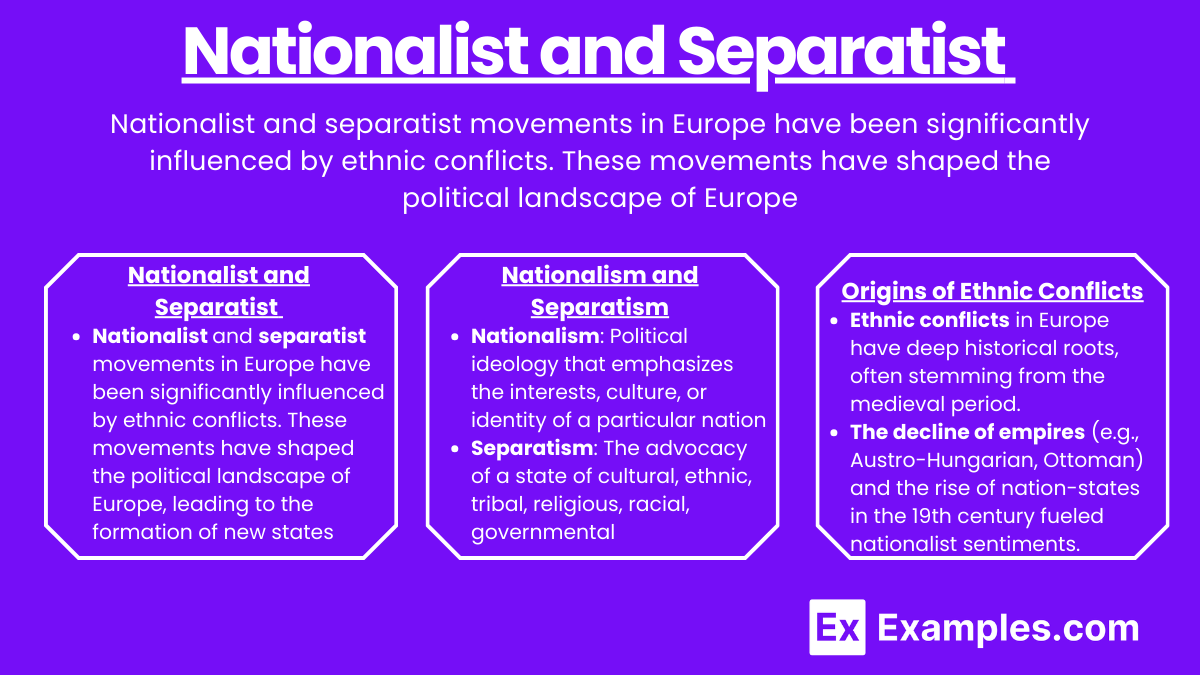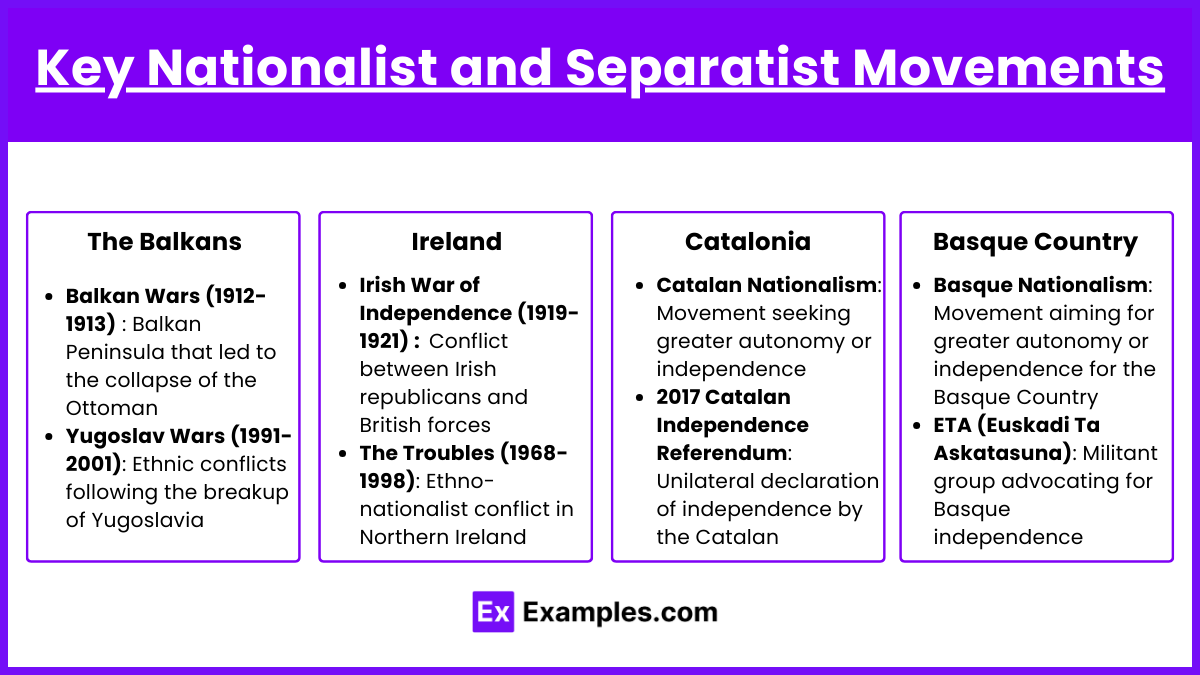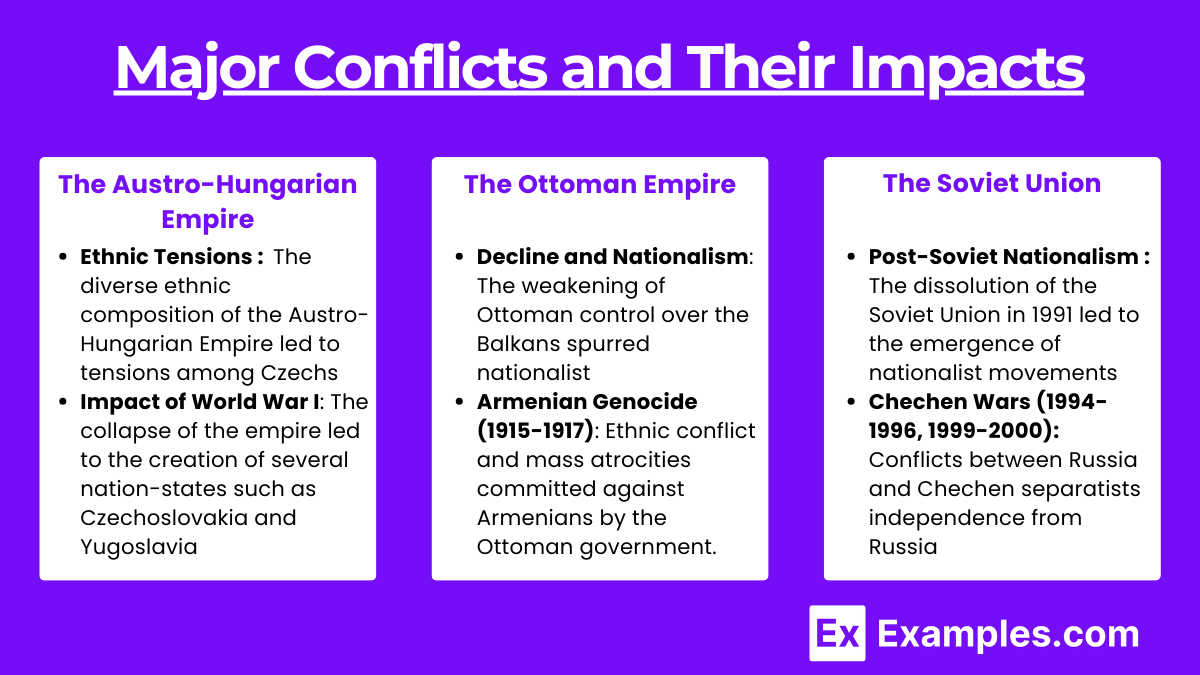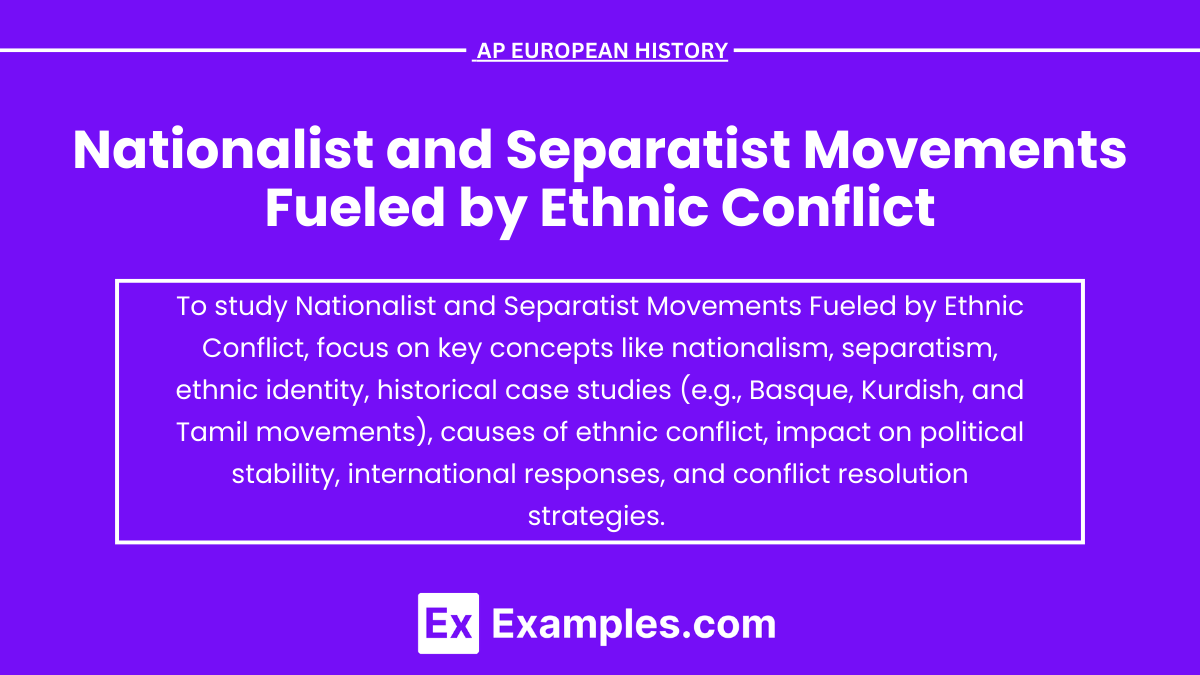Nationalist and separatist movements fueled by ethnic conflict have profoundly shaped European history, leading to the formation of new states and significant political upheaval. These movements, driven by the desire for self-determination and cultural identity, are crucial topics in AP European History. Understanding the causes and consequences of these conflicts provides insight into the complexities of European politics and society. From the Balkans to the Basque Country, these movements have left an indelible mark on the continent's historical landscape.
Learning Objectives
In studying "Nationalist and Separatist Movements Fueled by Ethnic Conflict" for the AP European History exam, you should aim to understand the causes and consequences of ethnic conflicts in Europe. Focus on key movements, such as those in the Balkans, Ireland, Catalonia, and the Basque Country, and their historical context. Analyze how the decline of empires and the rise of nation-states fueled nationalism and separatism. Examine the political, social, and geographic impacts of these movements, including boundary changes and international interventions.
Nationalist and Separatist

Nationalist and separatist movements in Europe have been significantly influenced by ethnic conflicts. These movements have shaped the political landscape of Europe, leading to the formation of new states, altering national boundaries, and causing significant political and social upheaval. Below, we will delve into the historical background, key movements, major conflicts, and their impacts on Europe.
Nationalism and Separatism
Nationalism: A political ideology that emphasizes the interests, culture, or identity of a particular nation, often in opposition to foreign control or influence.
Separatism: The advocacy of a state of cultural, ethnic, tribal, religious, racial, governmental, or gender separation from the larger group.
Origins of Ethnic Conflicts
Ethnic conflicts in Europe have deep historical roots, often stemming from the medieval period.
The decline of empires (e.g., Austro-Hungarian, Ottoman) and the rise of nation-states in the 19th century fueled nationalist sentiments.
Key Nationalist and Separatist Movements

The Balkans
Balkan Wars (1912-1913): Series of conflicts in the Balkan Peninsula that led to the collapse of the Ottoman Empire’s influence in Europe.
Yugoslav Wars (1991-2001): Ethnic conflicts following the breakup of Yugoslavia, resulting in the independence of several states, including Slovenia, Croatia, Bosnia and Herzegovina, Montenegro, and Kosovo.
Ireland
Irish War of Independence (1919-1921): Conflict between Irish republicans and British forces leading to the establishment of the Irish Free State.
The Troubles (1968-1998): Ethno-nationalist conflict in Northern Ireland between Unionists (mainly Protestant) and Nationalists (mainly Catholic), ending with the Good Friday Agreement.
Catalonia
Catalan Nationalism: Movement seeking greater autonomy or independence for Catalonia from Spain.
2017 Catalan Independence Referendum: Unilateral declaration of independence by the Catalan government, leading to a constitutional crisis in Spain.
Basque Country
Basque Nationalism: Movement aiming for greater autonomy or independence for the Basque Country from Spain.
ETA (Euskadi Ta Askatasuna): Militant group advocating for Basque independence, active from 1959 until 2018 when it disbanded.
Major Conflicts and Their Impacts

The Austro-Hungarian Empire
Ethnic Tensions: The diverse ethnic composition of the Austro-Hungarian Empire led to tensions among Czechs, Slovaks, Hungarians, Serbs, Croats, and others.
Impact of World War I: The collapse of the empire led to the creation of several nation-states, such as Czechoslovakia and Yugoslavia, driven by nationalist aspirations.
The Ottoman Empire
Decline and Nationalism: The weakening of Ottoman control over the Balkans spurred nationalist movements among Serbs, Greeks, Bulgarians, and others.
Armenian Genocide (1915-1917): Ethnic conflict and mass atrocities committed against Armenians by the Ottoman government.
The Soviet Union
Post-Soviet Nationalism: The dissolution of the Soviet Union in 1991 led to the emergence of nationalist movements in newly independent states like Ukraine, Georgia, and the Baltic countries.
Chechen Wars (1994-1996, 1999-2000): Conflicts between Russia and Chechen separatists seeking independence from Russia.
Long-Term Consequences
Redrawing of National Boundaries
Nationalist and separatist movements have often led to the redrawing of national boundaries, as seen in the Balkans, Eastern Europe, and the former Soviet Union.
Political and Social Upheaval
Ethnic conflicts have resulted in significant political and social upheaval, including civil wars, ethnic cleansing, and large-scale migrations.
International Interventions
Many ethnic conflicts have drawn international attention and intervention, such as NATO’s involvement in the Yugoslav Wars and the UN’s role in mediating the Cyprus conflict.
Contemporary Implications
Ongoing ethnic conflicts and nationalist movements continue to pose challenges to European stability and integration, such as the tensions in Ukraine and the rise of right-wing nationalism in several European countries.
Understanding the historical context and the driving forces behind nationalist and separatist movements is crucial for analyzing their impacts on Europe’s political landscape. Ethnic conflicts have played a pivotal role in shaping modern Europe, leading to both the creation of new nations and significant challenges to peace and stability.
Examples
Example 1 : Kurdish Independence Movement
Region: Middle East (Turkey, Iraq, Syria, Iran)
Description: The Kurds, an ethnic group spread across several countries, have long sought an independent Kurdish state. The struggle has included both political efforts and armed conflict, particularly intense in Turkey, where the Kurdistan Workers' Party (PKK) has waged an insurgency.
Example 2 : Catalan Independence Movement
Region: Spain
Description: Catalonia, a region with a distinct language and culture, has pursued independence from Spain. The movement gained significant momentum in recent years, especially after a 2017 referendum declared illegal by the Spanish government. The drive for independence has led to political unrest and confrontations.
Example 3 : Tibetan Independence Movement
Region: China
Description: Tibetans have sought independence from China since the Chinese invasion in 1950. The movement, led by the Dalai Lama and the Tibetan government-in-exile, advocates for greater autonomy and preservation of Tibetan culture and religion. The Chinese government has suppressed these efforts, leading to international protests and advocacy.
Example 4 : Chechen Independence Movement
Region: Russia
Description: The Chechen people have engaged in violent and non-violent efforts to gain independence from Russia. Two brutal wars in the 1990s and early 2000s resulted in significant casualties and destruction. Despite heavy Russian control, there remains a strong desire for independence among many Chechens.
Example 5 : Rohingya Crisis
Region: Myanmar (Burma)
Description: The Rohingya, a Muslim ethnic minority in predominantly Buddhist Myanmar, have faced severe persecution and violence, which many describe as ethnic cleansing. Large numbers have fled to neighboring countries. The Rohingya seek recognition, citizenship, and the right to return to their homeland with safety and dignity.
Multiple Choice Questions
Question 1
Which of the following is a primary cause of nationalist and separatist movements fueled by ethnic conflict?
a) Economic stability
b) Ethnic identity and cultural differences
c) Globalization
d) Technological advancements
Answer: b) Ethnic identity and cultural differences
Explanation: Nationalist and separatist movements are often driven by ethnic identity and cultural differences. These movements arise when a distinct ethnic group within a larger political entity feels that their cultural, linguistic, or historical identity is being suppressed or inadequately represented. The desire to preserve and promote their unique identity often leads to demands for greater autonomy or complete independence.
Question 2
Which historical event is an example of a nationalist movement driven by ethnic conflict?
a) The Industrial Revolution
b) The French Revolution
c) The dissolution of Yugoslavia
d) The signing of the Magna Carta
Answer: c) The dissolution of Yugoslavia
Explanation: The dissolution of Yugoslavia in the 1990s is a significant example of nationalist movements driven by ethnic conflict. The country was home to multiple ethnic groups, including Serbs, Croats, Bosniaks, Slovenes, and others. Ethnic tensions and a desire for independence among these groups led to a series of wars and the eventual breakup of Yugoslavia into several independent states.
Question 3
Which of the following is a common outcome of nationalist and separatist movements fueled by ethnic conflict?
a) Economic prosperity and development
b) Increased political stability
c) Creation of new national borders
d) Decreased social tension
Answer: c) Creation of new national borders
Explanation: A common outcome of nationalist and separatist movements fueled by ethnic conflict is the creation of new national borders. When ethnic groups seek to establish their own independent states, the result is often the redrawing of political boundaries. This process can lead to the formation of new countries and significant geopolitical changes. However, it is also frequently accompanied by violence, displacement, and prolonged instability.


